Learning targets are the foundation of effective teaching and learning. They give us a clear direction, establish our focus, and provide a means to measure success. This article delves into the world of learning targets, exploring their significance in the classroom, their benefits for both students and teachers, and how to create them effectively.
By the end of today’s lesson, you’ll be able to confidently say, ‘I understand learning targets, and I can create them for my own classroom.’ Let’s get started on this journey of educational improvement.
Table of Contents
- What Is A Learning Target?
- Why Use Learning Targets?
- 6 Advantages of Enhancing Student Learning Through Learning Targets
- How Teachers Benefit from Learning Targets
- How to Create Learning Targets
- Best Practices & Tips
- Learning Target Examples
- Learning Targets FAQs
What Is A Learning Target?
Learning targets are goals we set for our students. They need to be concrete goals written and worded in a way that’s easy for students to understand. To empower students, clearly defined learning targets should begin with the words, “I can.”
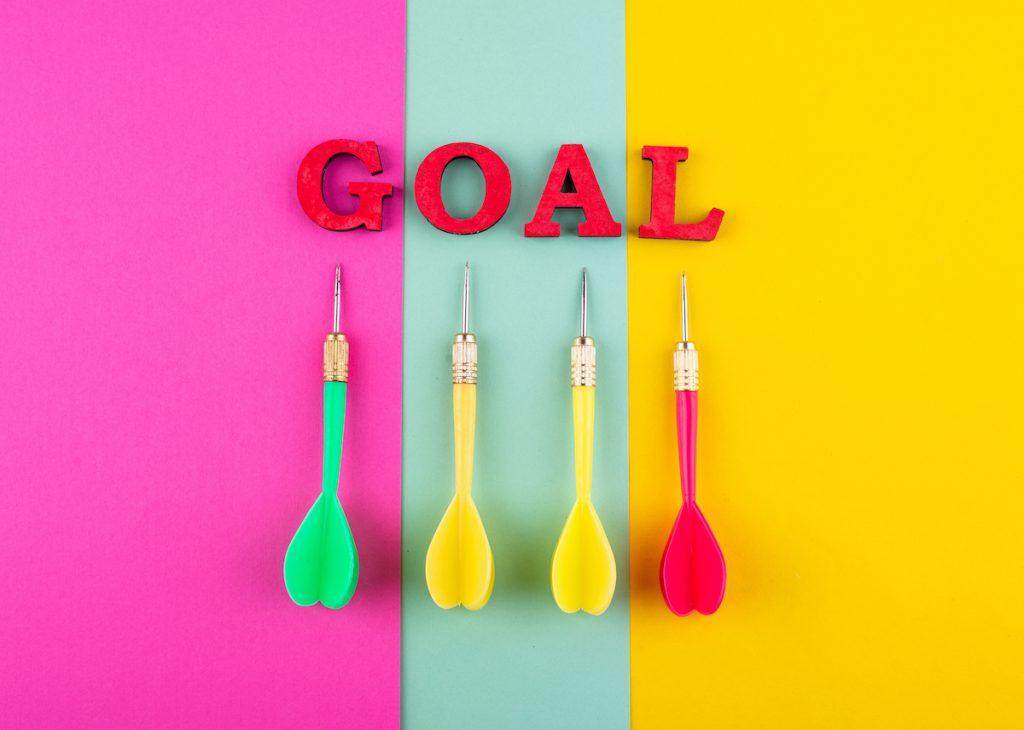
Why Use Learning Targets?
Goal-setting is an important skill to teach kids. In academics, the use of learning targets comes with a variety of benefits. Students can also use goal-setting skills to be successful their whole lives. Let’s go over some of the best reasons to incorporate them into your teaching practice.
6 Advantages of Enhancing Student Learning Through Learning Targets
1. Increased Achievement
As the saying goes, you don’t know what you don’t know. Understanding exactly what it is you’re supposed to be learning makes it infinitely easier to reach that goal. Learning targets help students grow by informing them exactly what they need to learn.
2. Added Motivation
Just as kids love reaching the next level in a video game, they feel highly motivated to follow through on learning objectives when students understand that there is a clear next step to aim for. A goal helps students become more engaged.
3. Personal Responsibility
Using “I can” statements are verry important reason. They place the responsibility and cognitive process of learning directly on the student. Saying “I can” promotes personal responsibility and confidence.
4. A Boost in Feedback
Knowing what the target is informes a student when they’ve reached it. And if they haven’t, knowing where the target is provides feedback they can use to understand how near or far they are.
5. Improved Self-Reflection Abilities
Putting the student in the driver’s seat of their own education naturally encourages them to be curious about how they’re doing. Knowing the goalposts will get them in the habit of reflecting on their own work and progress.
6. Better Communication
Learning targets are phrases for students to describe their skills succinctly and with confidence. They also help a student prove a skill has been learned. While our use of them in the classroom may be as a motivational statement, consider this: when they grow up to write resumes and go on job interviews, they’ll need this same skill! What a great time to start your students learning how to speak confidently and clearly about your abilities.

How Teachers Benefit from Learning Targets
1. Focused Teaching
Clear goal-setting helps teachers focus on the most important areas to teach. When you know exactly what you’re striving for, you’ll be able to cut any fat and hone in on the most relevant teaching material.
2. Improved ability to assess your students
Just as the student will have a better understanding of their progress, so will you. That’s really helpful to you as you assess your own teaching and determine what’s working for you and your small groups of students.
3. Be better able to explain students’ progress
Because you have your own clear understanding of your students’ progress, you’ll have a much easier time communicating it to parents and schools. The learning target already gives you great wording to describe students’ successes and areas for improvement.
4. Career Advancement
Setting your own learning targets will make you a better teacher. A teacher that gets top results in the classroom can use that to advance their career.
How to Create Learning Targets
Now that you understand the great benefits that come with implementing this strategy into your teaching, let’s go through exactly how to create powerful learning targets.
Learning Target Types.
First, start by identifying which target type is best for your students and goals.
- Knowledge-level: These pertain to factual, procedural, and conceptual knowledge. Ie, knowing things from memory, knowing how to execute a process, and the ability to explain concepts.
- Reasoning-level: Reasoning targets use verbs like “predict, infer, compare, hypothesize, critique, draw conclusions, justify, and evaluate.”
- Skill-level: In this context, “skill” refers solely to physical activities, such as those executed in gym class, the study of foreign languages, or the practice of fine and performing arts.
- Product-level: This is the creation of physical products, such as 3D models, or a piece of writing.
Concrete Learning Objectives
This could be a small goal, or it could be a larger goal that you can also break down into smaller learning targets. You can use national or state standards to guide your choice of age-appropriate goals for your classroom. This Progression of ELA Common Core Standards PDF includes 68 ready-to-view/print pages of goals by grade level for middle school through high school students.



Employ Success Criteria
Learning targets and success criteria go hand-in-hand. Success criteria are the methods used to judge whether a target has been met. When coming up with success criteria, think of verbs you want your student to be able to do. Some examples include define, explain, build, create, or write. Success criteria are what make the learning goal more concrete and measurable. Both you and the student need to know when they’ve hit the bullseye.
State the Goal: Write Learning Targets
State the Goal in a way that’s empowering. Begin with the words “I can,” followed by succinct, easy-to-understand language. The learning target should not include words students don’t already know. They need to be written in student friendly language.
Set a Timeframe
Set a Timeframe for the learning target to be achieved. This might be by the end of class, the end of a project or unit, or the end of the school year.
Best Practices & Tips
Alright, you’ve got some great learning targets you want to use with your students, now what?
Make Them Visible
Display your learning targets somewhere that’s easy for students to see.This helps keep those targets fresh in their minds as they work. Some good places to display a learning target is on bulletin boards, whiteboards, and chalkboards. It’s also a great idea to put them on homework assignments, syllabi, and test prep materials.
Frequency
Bring up the learning targets at least once per lesson. Having an auditory reminder of their daily learning targets and goals by way of you saying them aloud is another incredibly helpful way for students to keep them front of mind.
Student Friendly Language
Make sure the teacher and whole class understands each learning target. The benefits of writing learning targets will go right out the window if your students don’t understand. Encourage your students to ask questions, but also ask them to put the learning targets in their own words.
More:
- Use student-friendly language to word learning targets.
- Phrase with empowering, “I can” statements.
- Incorporate the repetition of learning targets in each lesson.
- Learning targets don’t only have to be academic. You can use them to foster personal development as well. For example, students can work on learning targets like listening skills, public speaking, mood regulation, and beyond.
- Another technique to try is reverse-engineering learning targets. Work through a lesson or a project, and then ask students what they thought the learning target was. This helps develop skills of reflection.
Learning Target Examples
We’ve talked about what you need to do to engage students and craft excellent learning targets, but you’re a teacher, so you know an example always helps! Below are a few learning target examples by subject.
Math Learning Target Examples
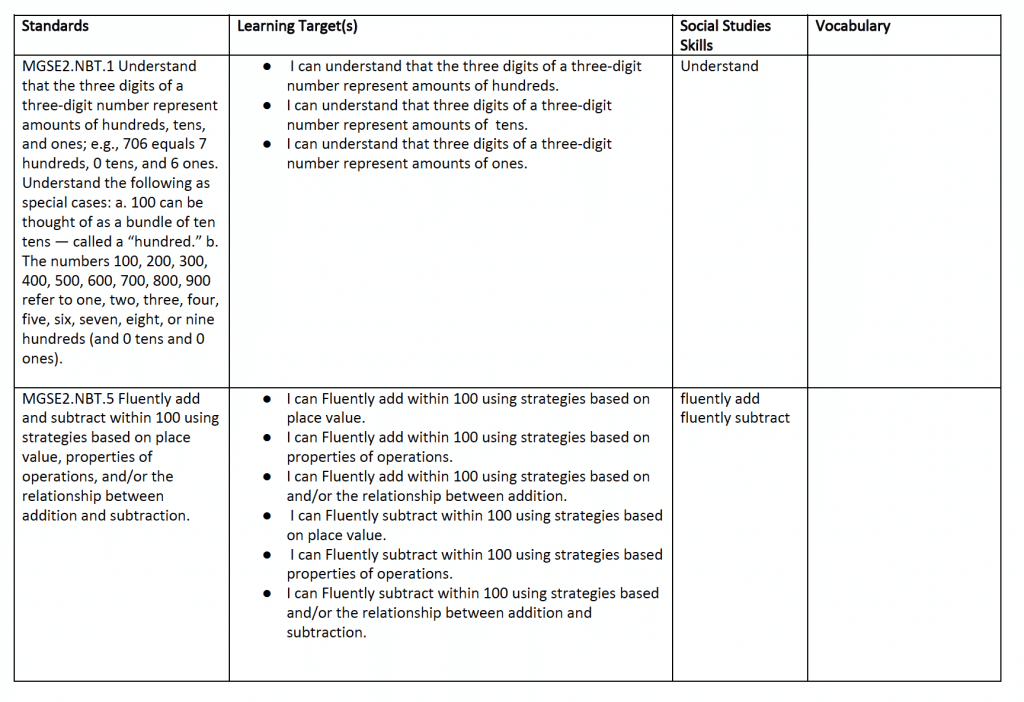
These learning targets are used by Henry County Schools in Georgia for 2nd grade math:
- I can mentally add 10 to a given number 100–900.
- I can explain why addition strategies work using place value.
- I can measure the length of an object by selecting appropriate tools such as rulers.
- I can use subtraction within 100 to solve word problems involving lengths that are given in the same units.
Language Arts Learning Target Examples
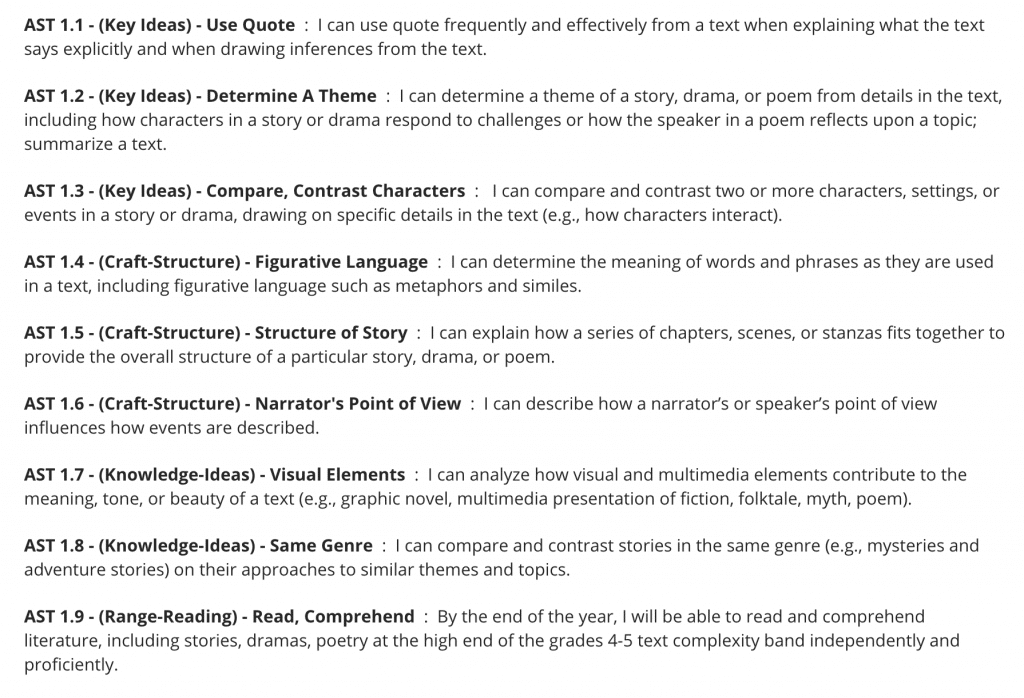
Beaverton School District in Beaverton, OR utilizes these learning targets for 5th-grade language arts:
- I can use quotes frequently and effectively from a text when explaining what the text says explicitly and when drawing inferences from the text.
- I can explain the relationships or interactions between two or more individuals, events, ideas, or concepts in a historical, scientific, or technical text based on specific information in the text.
- I can integrate information from several texts on the same topic in order to write or speak about the subject knowledgeably.
- I can explain the function of conjunctions, prepositions, and interjections in general and their function in particular sentences.
Science Learning Target Examples
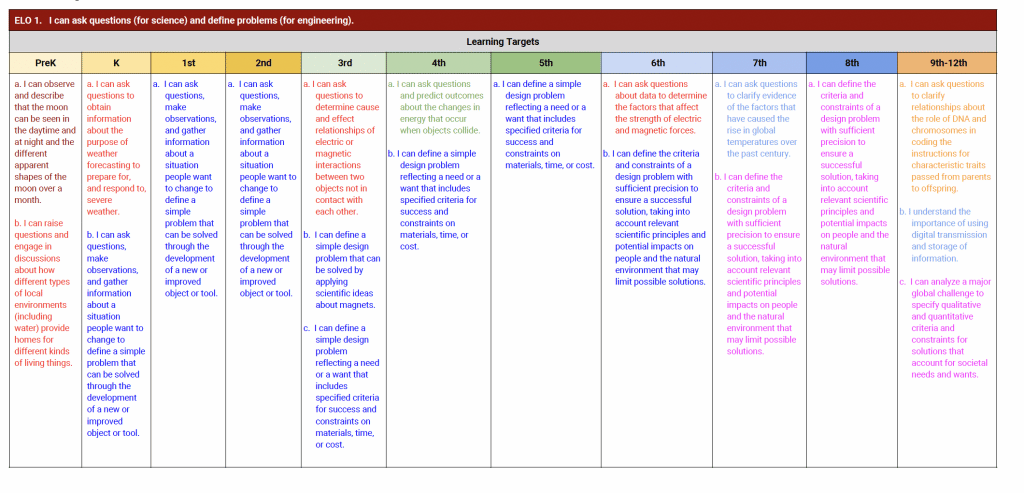
Addison Central School District in Middlebury, VT uses these learning targets for 1st-grade science teachers:
- I can develop a simple sketch, drawing, or physical model to illustrate how the shape of an object helps it function as needed to solve a given problem.
- I can plan and conduct investigations to provide evidence that vibrating materials can make sound and that sound can make materials vibrate.
- I can use materials to design a solution to a human problem by mimicking how plants and/or animals use their external parts to help them survive, grow, and meet their needs.
- I can read texts and use media to determine patterns in the behavior of parents and offspring that help offspring survive.
Social Studies Learning Target Examples
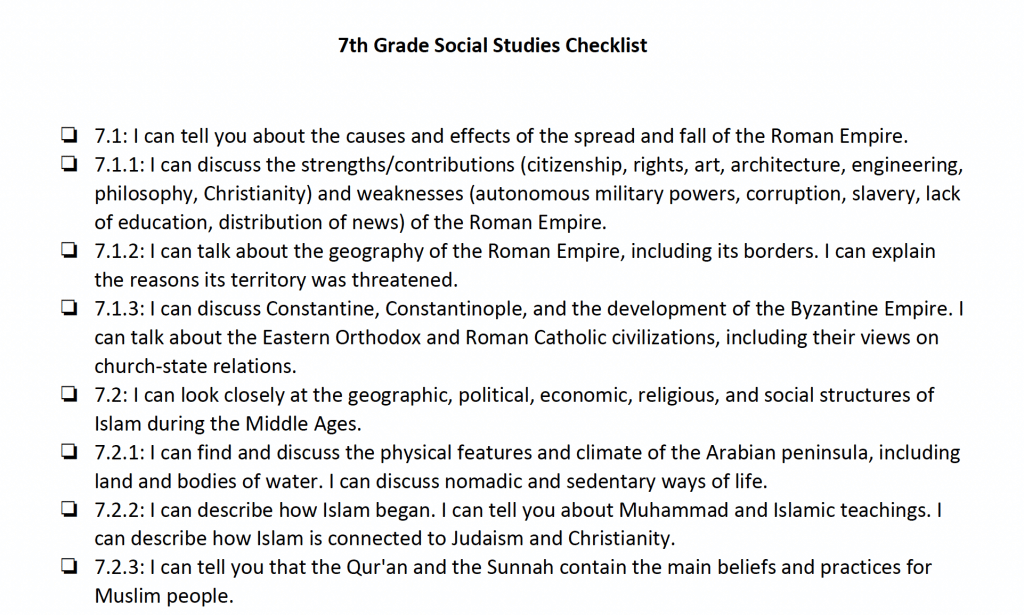
Here are a few examples of 7th Grade Social Studies learning targets program materials employed by Yosemite Valley Charter School in Fresno, CA:
- I can discuss the importance of family, specialized jobs, and local commerce in the growth of West African states and cities.
- I can explain how Christianity spread north of the Alps, and the role that the church and monasteries played after the Roman Empire fell.
- I can tell you about the goods and ideas that were traded among Europe, Africa, Asia, and the Americas during the 15th and 16th centuries. I can talk about the impact of these exchanges on each continent.
- I can discuss how modern-day capitalism first began. I can tell you about different influences such as mercantilism, the cottage industry, the market economy in 17th-century Europe, international trading/marketing patterns, explorers, and map makers.
You can also try out ready-to-print and display learning targets, such as this PDF of ELA Learning Targets & “I Can” Statements for 8th Grade



Learning Targets FAQs
Below are a few example used by the special education program of Jordan School District in West Jordan, UT:
I can identify emotions, thoughts, or triggers associated with my depression and/or anxiety in order to develop and utilize coping strategies
I can identify and demonstrate at least 5 emotional regulation skills that are effective for me.
I can determine healthy ways to accept, manage, and adapt to changes in relationships.
I can identify and demonstrate appropriate social skills with classroom peers.
Unlike learning targets, objectives are written from the teacher’s point of view and address the educator’s goals. These are often worded as “we will” statements.
Learning targets are all for naught if they aren’t reflected in learning activities and assessments. Imagine teaching students about the French Revolution, and then giving them a quiz on the Pythagorean Theorem. Use your learning targets to inform each step of your teaching.
